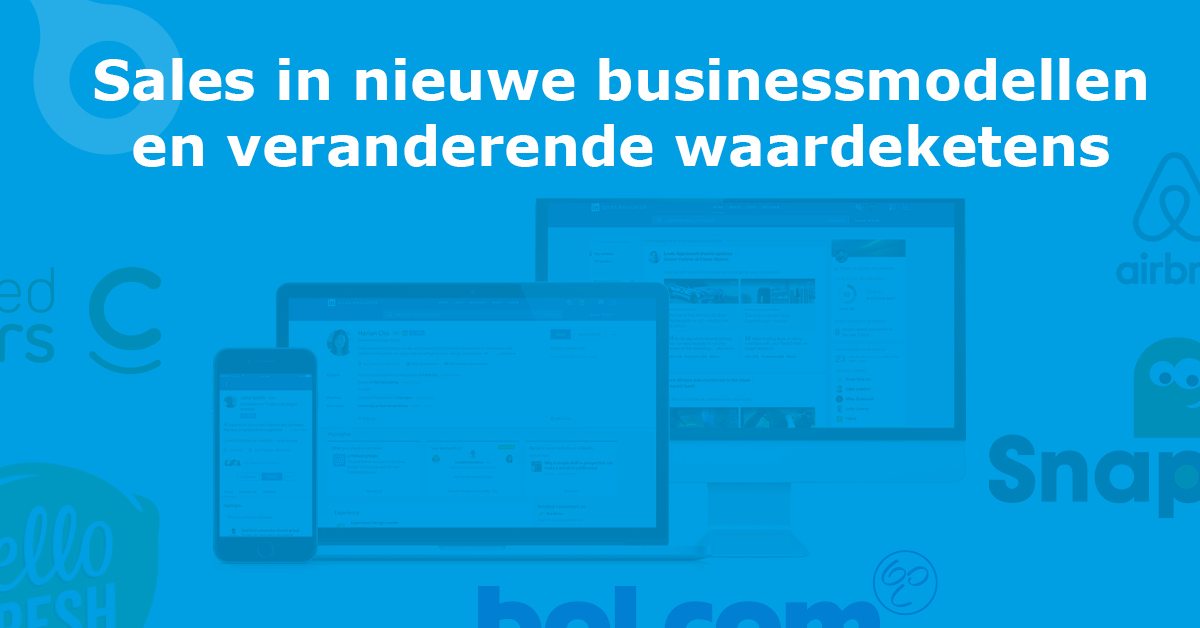
Sales in New Business Models and Changing Value Chains
Do you know the opportunities and threats in your market or business column?
As a director or sales manager, it's important to have insight into changes in your market. Technological applications and social changes, for example, lead to new business models. Chains and the role of players in business columns also change. Each of these changes can be an opportunity or a threat. In any case, they change the role of sales. Do you have a picture of how business models are changing, how your customers are organizing themselves, and what new entrants are coming to the market?
Technology changes the role of every company in the chain
As the world becomes smaller and more transparent, it's easier for companies to obtain products, for instance. This not only changes the role of sales but of entire companies in the chain. For example, the role of the wholesaler or retailer is now under pressure. Customers also increasingly become producers themselves (think of energy) or designers (via 3D applications). More and more steps in chains are being skipped. The challenge for every player in the chain is therefore to make their added value clearer. Reflect critically on your own role and that of other players in your chain. Analyze where forward and backward integration opportunities lie or where entire steps can be completely skipped. There lie your opportunities and threats.
New business models and the role of sales
Technological changes lead to new business models. It's important to know these and perhaps experiment with them. New business models do not necessarily have to replace existing ones. They can be an addition or lead to a hybrid business model.
This keeps you flexible and agile.
The platform model and sales
Sales are increasingly handled via third-party platforms. Think of Bol.com or AliExpress, where brands and producers sell directly to customers. Drukwerkdeal.nl is a business example. The advantage is that as a producer, you don't have to do your own marketing or sales. The disadvantage is that you give up part of the margin to the platform and that you don't establish a direct connection with customers. Sales mainly focus on attracting selling parties.
The subscription and as-a-service model and sales
ECI book club has become famous with it, but now the subscription model is taking off. Think of subscriptions to food (HelloFresh), razors (Dollar Shave Club), and bikes (Swapfiets). This also has to do with the movement from ownership to use. The advantage of this model is predictability, steady cash flow, and direct communication with customers. In B-2-B, this business model is becoming more common: think of the 'as a service' models of software companies like Salesforce and Adobe. These models require a different sales approach. For example, you no longer sell software packages but usage rights for employees. Sales thus have different contact persons, conversation content, and closing techniques.
The circular economy model and sales
Companies are increasingly aware of their effects on the earth and want to take responsibility. Thus, circular business models are emerging, where companies create products from waste streams. Think of demolition companies that only earn money by selling building materials. Companies that produce circularly are also emerging, like Fairphone, which produces phones with the recycling of all parts as a starting point. Besides the economic value of these business models, the added benefit is of course saving the earth and the goodwill this generates with customers. The DMU for these business models is therefore much broader than just procurement.
The bundled purchasing power
Customers can also bundle their purchasing power, for example, through UnitedConsumers.com, Vereniging Eigen Huis, or through the employer. These parties present the collective demand of their supporters to gas companies, telecom companies, insurers, publishers, or energy companies. The collective then receives a tailored offer that they can accept or decline. The roles between supplier and customer are thus reversed. If you're not a supplier or don't have a competitive offer, you lose the battle for the customer. Sales must therefore mainly establish contacts with already organized or organizing parties.
Tools for a Modern Sales Organization
Sales Improvement Group helps companies improve results by optimizing sales organizations and training people. We always look at current and future movements in the market and the sales organization. Looking ahead is, after all, a crucial part of a modern sales strategy.
Our vision on making your sales organization future-proof is shared through blogs and whitepapers. If you want more tools to prepare for the future of sales, then read the whitepaper ‘Trends & Modern Selling’.
Better sales result
Yes, I want to know more about how Sales Improvement Group can help me improve the sales results of my organization.
Blogs
How to develop the right competencies at any time with an internal AcademyThe secret of targeted competency development
Win with strategic employee development
Integrate sales and marketing for +30% more success
Leadership and culture in Covid times
Learn from Mike Tyson: What do you do when Covid strikes hard
4 generations in your sales team
Sales in new business models and changing value chains
Sales shifts from human to technology?
National Benchmark sales optimization
Does your sales team recognize buying signals?
Sales Pipeline management en de crisis
Postponement of decisions - What are we waiting for?
10 Tips for professional conversation preperation
International market development
What competencies does a top seller have?
Break into a new market
Becoming top seller secret
Result oriented sales management